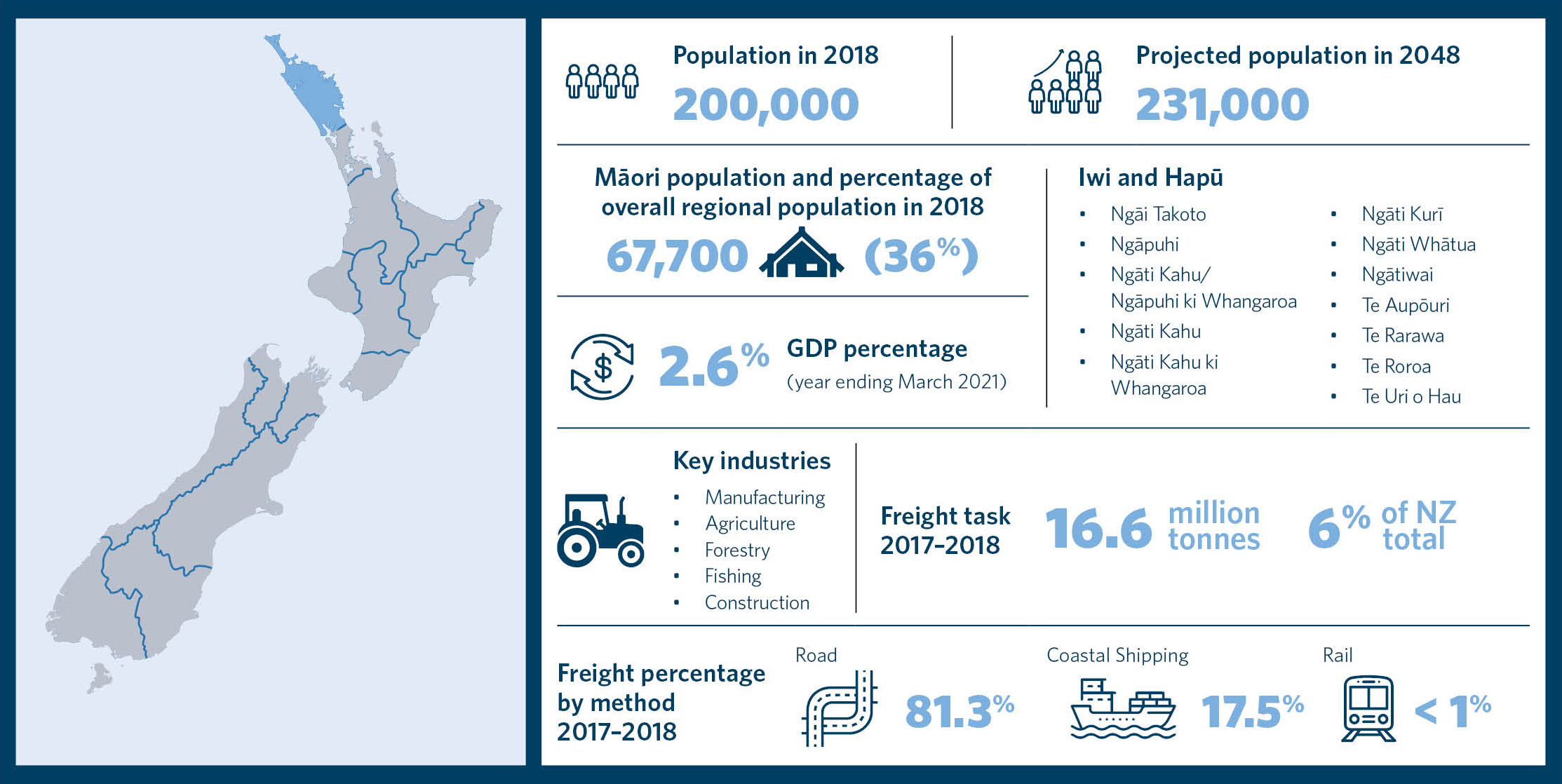At a glance

Arataki Te Tai Tokerau – Northland regional direction [PDF, 14 MB]
Arataki Northland statistics table – infographic alternative [PDF, 114 KB]
The September 2023 v1.1 release of Arataki includes updates to reflect the severe weather events of 2023 and make minor corrections. Most sections of the Arataki Te Tai Tokerau – Northland regional direction have climate-related updates.
Te Tai Tokerau Northland depends on its rail and road connections south to Tāmaki Makaurau Auckland and the rest of Aotearoa New Zealand. These connections support social benefits, like helping communities thrive, and economic opportunities for the key industries of tourism, horticulture, forestry, and manufacturing.
In recent years, Te Tai Tokerau has grown faster than any other region in the country. This has put pressure on housing and infrastructure, including transport.
About half the region’s population lives in the Whangārei district, with growth rates varying across the region. Some areas are growing rapidly; others are in decline. Overall, the region’s population is expected to grow from 200,000 to 231,000 by 2048.
Most growth has occurred as low-density housing. Whangārei has allowed for greater density growth; this has yet to be taken-up. This area is highly dependent on cars because of low density of development, dispersed rural and coastal communities, and limited public transportation.
Te Tai Tokerau has one of the highest rates of road deaths and serious injuries of any region. Key safety challenges include poor vehicle condition, speeding, drug and alcohol impairment, fatigue, and not using seat belts.
The region’s transport system is vulnerable to sea-level rise, flooding, intense storms, and slips. Many communities in Te Tai Tokerau are often accessed by one road or state highway. The region’s transport network is also vulnerable to resilience challenges. This is because the only road and rail connections from the region to the rest of the country is through Tāmaki Makaurau.
Focusing our efforts
For efficient and effective progress, the transport challenges for Te Tai Tokerau Northland must be tackled in a cohesive way. The directions below identify the most important issues to be resolved over the next 10 years to make progress towards transport outcomes.
- Significantly reduce the harm caused by the transport system of Te Tai Tokerau, especially through improved road safety and reduced pollutants dangerous to health.
- Reduce vehicle kilometres travelled, focusing on Whangārei, in a way that’s fair, equitable, and improves quality of life.
- Plan and deliver growth in Whangārei and key townships, such as Kerikeri and Mangawhai, in an affordable and cost-effective way that aligns with safety and emissions-reduction goals.
- Support the prosperity of Te Tai Tokerau by providing a safe, efficient, and resilient transport network that helps address low incomes, supports Māori economic opportunities, and improves access for rural communities to employment, training, and education.
- Increase resilience by focusing on key connections and communities at risk, as well as important road and rail connections to Tāmaki Makaurau Auckland and Northport.
- Provide communities with access to a range of social and economic opportunities by public transport, walking, and cycling.
- Work with local government, developers, and agencies to support and encourage development in areas that already have good travel choices and shorter average trip lengths.
- Rapidly accelerate the delivery of walking and cycling networks with a focus on completing existing planned networks in Whangārei and reshaping existing streets, to make these options safe and attractive.
- Improve and expand public transport services, including potential on-demand services, to improve access to social and economic opportunities.
- Identify and support opportunities to move to a multimodal freight system with greater use of rail and coastal shipping.
- Work with communities and councils to identify and confirm how key resilience risks will be addressed over time.
- Progressively upgrade road and rail connections to Tāmaki Makaurau and Northport to improve the safety, efficiency, and resilience of these critical links to the rest of Aotearoa New Zealand.
- Confirm how resilience risks will be addressed over time, and work with communities to plan for when to defend, accommodate, or retreat.
- Continue to implement road safety plans and programmes including those focused for iwi Māori.
- Reduce financial and other barriers to iwi Māori getting a driver’s licence in areas not well served by public transport.
- Improve or maintain, as appropriate, physical access to marae, papakāinga wāhi tapu, and wāhi taonga.
These will be updated over time to focus effort on the most critical matters.
Arataki Te Tai Tokerau – Northland regional direction [PDF, 14 MB]
